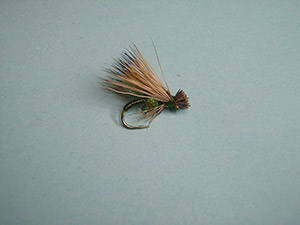ELK-HAIR CADDIS EMERGER
SHANE STALCUP Translated by CARL WUEBBENCaddis are the meat and potatoes of most trout diets. This important group of insects is found in just about every river, stream, and pond in which you might cast flies for trout. Caddis have several life stages, all of which can be imitated by artificial flies but we will concentrate on the emerger stage with this one. Emerging caddis larvae leave the Lake Bottom or streambed to swim to the surface, where they become winged adults. The swimming caddis pupae are weak and vulnerable, and they drive trout nuts. It’s best to keep floatant off of the bodies of this fly; for a realistic presentation, you want the body to hang down in the surface. This fly is just the ticket for catching tough – highly pressured trout.
PATTERN
HOOK – Daiichi 1130 or a similar bent – shank nymph hook, sizes #10 - #16
THREAD – 8/0, color to match the body
ABDOMEN – D-rib, color to match the body or clear to allow the color of the thread to show thru.
THORAX – Ice dubbing, color to match the body.
UNDERWING – Ice dubbing, color to match the body.
LEGS – Partridge hackle fiber.
WING – Elk or deer hair.
HOW TO TIE
- Debarb hook – mount in vise – start your thread in at about three eyelets from the eye and wrap a nice thread base going a little bit into the hook bend, then take your D-rib and cut it at a slight angle at the tip – tie it in at the bend of the hook and bring your thread forward to the tie in point, then wrap the D-rib forward also with nice close wraps and end it where your thread is and tie it off (this is your abdomen) now clip off the tag end of the D-rib.
- Tie in a pinch of dubbing by the tips In front of the abdomen – leave it hanging toward the rear as this will be doubled over later for the underwing – put some dubbing wax on the thread then add a small pinch of dubbing to the thread and with your fingers twist the dubbing onto the thread to make a rope like thread and dub a thorax (a small one) by wrapping the thread rope around the hook just a couple times. Leave room for the elk hair.
- Using your bodkin , fold the dubbing underwing over it and tie it in front of the thorax – clip off any tag ends of dubbing and any stray pieces in the underwing loop (The loop creates a little air pocket).
- Take a partridge feather and strip off the fuzz so you have just the good fibers on the shank. Gently pull the fibers on one side straight out but don’t strip them off – now tie in a small section of the fibers on the bottom of the thorax and in front of it (The thorax) for the legs – fibers should extend no farther than the hook point.
- Clip out a clump of elk hair from the hide (About the thickness of a pencil – you can remove what you don’t need later) then comb out the fuzz and put it in a hair stacker then tap it on the table a few times to even the tips of the hair - pull the hair out by the tips and size up the thickness according to the hook size. Tie in with the tips facing toward the bend of the hook (The hair should extend to just a bit before the hook bend). Take your hair in your left hand and with the bobbin in your right hand wrap the thread around the hair where you will be tying it in and take one full turn then bring it all down to the hook shank and tie it on in front of the thorax with soft wraps (2or3) to help control the hair on top then with a little more tension and wrapping forward about 3 or 4 wraps to corral the hair a little then as you go back to where you stated tying in the hair pull tighter and the butts of the hair will really flair out – try to keep them on top by pulling them back up with your fingers.
- Clip the hair butts at an angle just like an elk hair caddis but don’t cut it too short – you can always clip more but you can’t add any more on to it. Now just a few more thread wraps then a whip-finish and you’re done. Clip the thread off. Tie up a bunch - then take a photo of your best one and e-mail it to me and I can critique it for you if you want.
*** But remember to practice C.P.R. (CATCH – PICTURE – RELEASE).


